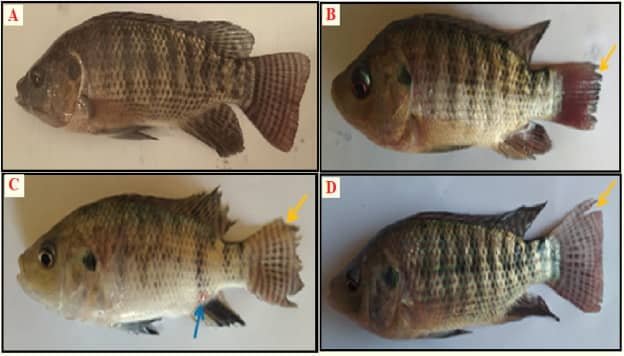
The search for eco-friendly alternatives to antibiotics in treating bacterial diseases affecting the aquaculture sector has become essential. This is primarily due to the fact that using antibiotics to treat bacterial diseases can lead to antimicrobial resistance, posing risks to consumer well-being.
In this context, herbal plants have emerged as promising alternatives, especially when combined with cutting-edge nanomaterials. Herbs offer a safe and eco-friendly alternative, as they contain a range of phytochemicals and secondary metabolites with antimicrobial functions.
A recent study conducted by researchers from Zagazig University, Mansoura University, King Saud University, and other academic institutions, has highlighted the revolutionary potential of Neem leaf extracts (Azadirachta indica), synthesized into chitosan nanocapsules, in treating challenges posed by Aeromonas sobria (A. sobria) in Nile tilapia.
The Challenge
The researchers synthesized a Neem (A. indica) extract using a chitosan nanocapsule. They tested chitosan-neem nanocapsules (CNNC) in vitro and in vivo by challenging the tilapia with the bacterial pathogen Aeromonas sobria.
A. sobria, a common bacterial pathogen, represents a significant threat to the health and sustainability of aquaculture operations. Conventional antibiotics have been the standard solution, but their environmental impact and the risk of antibiotic resistance have raised significant concerns. This study aimed to explore an innovative and eco-friendly approach using Neem-based nanocapsules.
Revealing the Healing Power of Neem Nanocapsules
The research began with a preliminary experiment involving 120 Nile tilapia. The goal was to determine the therapeutic dose of Chitosan-Neem Nanocapsules (CNNC), which was established at 1 mg/L. Armed with this information, a comprehensive treatment study was conducted over seven days, involving 200 fish divided into four groups:
- Control Group: Received no treatment and were not challenged with A. sobria.
- CNNC Group: Treated with 1 mg/L of CNNC without an A. sobria challenge.
- A. sobria Group: Challenged with A. sobria without CNNC treatment.
- CNNC + A. sobria Group: Treated with 1 mg/L of CNNC and challenged with A. sobria.
Innovative Discoveries
The results of this study were astonishing. In vitro experiments demonstrated CNNC’s antibacterial activity against A. sobria, with minimum inhibitory and bactericidal concentrations of 6.25 and 12.5 mg/mL, respectively.
Challenge with A. sobria in fish resulted in behavioral alterations, skin hemorrhages, fin rot, and a 60% decrease in survival. Biochemical analyses revealed that infected fish experienced an increase in malondialdehyde levels and hepato-renal function markers. Additionally, there was a significant decrease in antioxidant and immune indicators, such as catalase, reduced glutathione, lysozyme, nitric oxide, and complement 3 in the A. sobria group.
Stay Always Informed
Join our communities to instantly receive the most important news, reports, and analysis from the aquaculture industry.
However, hope emerged in the form of CNNC treatment. Fish challenged with A. sobria and treated with 1 mg/L of CNNC experienced a significant recovery in these parameters and a notable improvement in survival.
Conclusion
In conclusion, Chitosan-Neem Nanocapsules (CNNC) represent a revolutionary advancement in aquaculture health. At a concentration of 1 mg/L, CNNC emerges as a versatile and sustainable tool for combating challenges posed by A. sobria, offering an eco-friendly alternative to traditional antibiotics.
This research not only opens the door to healthier aquatic ecosystems but also highlights the potential of nature-inspired nanotechnology in revolutionizing aquaculture practices. As we continue to explore the synergies between herbal solutions and cutting-edge science, the future of sustainable aquaculture production appears brighter than ever.
Scientists recommend further research to determine how CNNC affects fish health at the molecular and histological levels, as well as to evaluate CNNC’s antibacterial activity against a wide range of fish pathogens.
Reference (Open Access)
Rowida E. Ibrahim, Gehad E. Elshopakey, Abdelwahab A. Abdelwarith, Elsayed M. Younis, Sameh H. Ismail, Amany I. Ahmed, Mahmoud M. El-Saber, Ahmed E. Abdelhamid, Simon J. Davies, Abdelhakeem El-Murr, Afaf N. Abdel Rahman. Chitosan neem nanocapsule enhances immunity and disease resistance in Nile tilapia (Oreochromis niloticus), Heliyon, Volume 9, Issue 9, 2023, e19354, ISSN 2405-8440, https://doi.org/10.1016/j.heliyon.2023.e19354
Editor at the digital magazine AquaHoy. He holds a degree in Aquaculture Biology from the National University of Santa (UNS) and a Master’s degree in Science and Innovation Management from the Polytechnic University of Valencia, with postgraduate diplomas in Business Innovation and Innovation Management. He possesses extensive experience in the aquaculture and fisheries sector, having led the Fisheries Innovation Unit of the National Program for Innovation in Fisheries and Aquaculture (PNIPA). He has served as a senior consultant in technology watch, an innovation project formulator and advisor, and a lecturer at UNS. He is a member of the Peruvian College of Biologists and was recognized by the World Aquaculture Society (WAS) in 2016 for his contribution to aquaculture.




